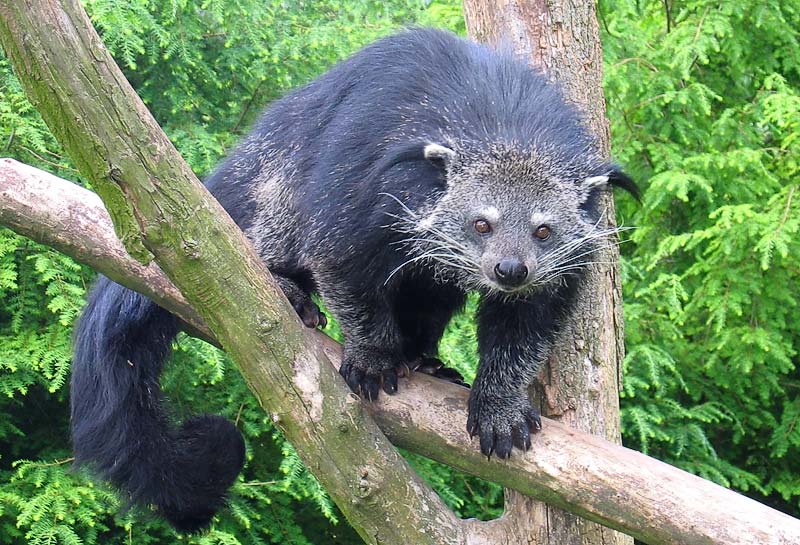- Viverridae
Taxobox
name = ViverridaeMSW3 Wozencraft | pages = 548-559]

image_width = 200px
image_caption =Binturong
regnum =Animal ia
phylum =Chordata
classis =Mammal ia
ordo =Carnivora
subordo =Feliformia
familia = Viverridae
familia_authority = Gray, 1821
subdivision_ranks = Subfamilies
subdivision =Paradoxurinae Hemigalinae Prionodontinae Viverrinae The family Viverridae is made up of 35 species, including all of the genets, the
Binturong , most of thecivet s, and the fourlinsang s.Viverrids are native to most of the Old World tropics, nearly all of
Africa (bar the area immediately south of theMediterranean ),Madagascar , and theIberian Peninsula . Favoured habitats include woodland, savanna, mountains and, above all,tropical rainforest . In consequence, many are faced with severe loss of habitat; several species are considered vulnerable and theOtter Civet is classified as endangered.Characteristics
Viverrids are amongst the primitive families of the
Carnivora , with skeletons very similar to those of fossils dating back to theEocene , up to 50 million years ago. They are variable in form, but generally resemble long-nosed cats. Most have retractile or partially-retractileclaw s, abaculum , and an analscent gland .Viverrids range in size from the African Linsang with a body length of 33cm, and a weight of 650g, to the African Civet at 84cm and 18kg.
They are nocturnal animals, with excellent hearing and vision. They are generally solitary. Despite their placement in the order Carnivora, they are omnivorous, or, in the case of the Palm Civets, almost entirely herbivorous. In reflection of this, their flesh-shearing
carnassial teeth are relatively undeveloped cite book |editor=Macdonald, D.|author= Wozencraft, W. Chris|year=1984 |title= The Encyclopedia of Mammals|publisher= Facts on File|location=New York|pages= 134-135|isbn= 0-87196-871-1] . The usual dental formula is:Classification
Although it resembles the other civets, the
African Palm Civet ("Nandinia binotata") is genetically distinct and belongs in its own monotypic family,Nandiniidae . The Madagascan Fossa "Cryptoprocta ferox" was similarly long thought to be a member of Viverridae, but genetic evidence indicates that this animal is a member of the familyEupleridae , an endemic Madagascan carnivore radiation related to the familyHerpestidae . Furthermore, recent genetic research indicates that theAsiatic linsang s of the genus "Prionodon", may be more closely related to the species of the familyFelidae ; if so, then they should be removed from Viverridae and placed in their own family,Prionodontidae . There is little dispute, however, that theAfrican linsang s of genus "Poiana" are viverrids.pecies
Civet/Genet Hybrids
In "The Variation Of Animals And Plants Under Domestication" Charles Darwin noted: "The Genetta has bred both here and in the Jardin des Plantes, and produced hybrids." Others have also reported civet/genet hybrids.
References
External links
* [http://www.awf.org/wildlives/73 Genet: Wildlife summary from the African Wildlife Foundation]
* [http://news.bbc.co.uk/2/hi/science/nature/4501152.stm BBC: 'New mammal' seen in Borneo]
* [http://animaldiversity.ummz.umich.edu/site/accounts/information/Viverridae.html University of Michigan's Animal Diversity Web page]
* [http://www.itis.usda.gov/servlet/SingleRpt/SingleRpt?search_topic=TSN&search_value=621757 ITIS page]
* [http://www.straightdope.com/columns/010525.html The Straight Dope on Civet Cats]
Wikimedia Foundation. 2010.
